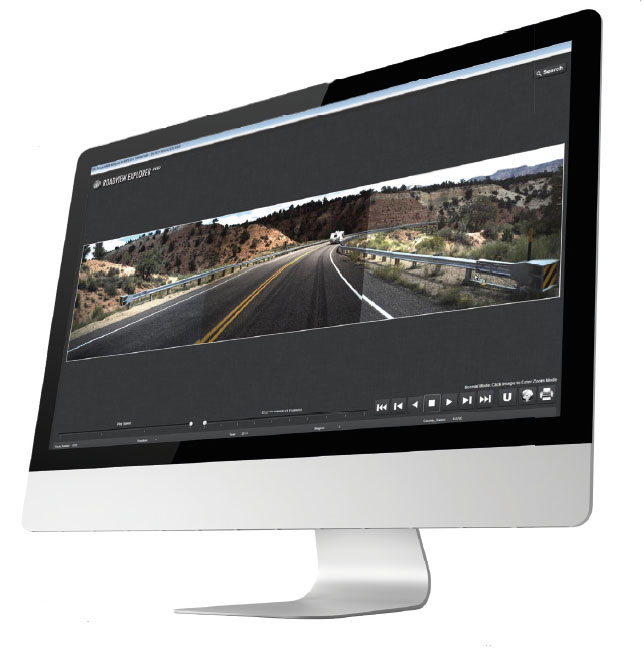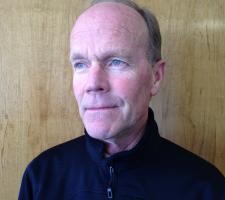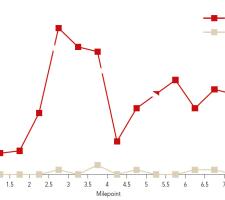
Overlaying a geographic information system with data from a new surveying system is paying dividends for Utah DOT.
While building new roads tramways, metros and bicycle paths or installing smart systems to control traffic is the high-profile end of transportation planning and management, ensuring existing infrastructure and systems are serviceable and working is arguably more important. After all, at any given point the existing infrastructure will always carry more vehicles than new.
However for Stan Burns, director of asset management at
Burns: “What happened in Utah was that funds had been allocated to replace the Texas turndown ends on barriers but the program was falling behind schedule because we didn’t know how many we had and where they all were. We also didn’t know how many signs and signals we had or how many drains and manhole covers there were in the roads. Then how do you even start working out what you need to maintain and when, let alone where to get the best return on any discretionary spend?”
Above ground
So UDOT decided to expand the vehicle-mounted surveying process to include the positioning and evaluation of road signs, gantries, cabinets and other above-ground assets. Burns’ team created the vision, drew up the business case and compiled the Roadway Imaging and Inventory Program. In late 2011 it issued a Request for Proposals for companies to devise a visual system to gather, identify and process a wide variety of roadway assets. This aimed to ‘deploy state of the art collection methods to improve and develop rigorous safety, maintenance and preservation programs’.
Each of those categoriesis then broken down into subcategories ranging from GPS location to condition assessments.
The winning bidder, Wisconsin company
Data gathering requires the vehicle to be driven at normal speeds along each road in each direction. On multilane stretches the vehicle remains in the right-hand lane which is usually subjected to greater damage because of a higher proportion of truck traffic.
“We capture everything from fencepost, to fencepost – and even beyond as we image billboards too,” says Burns.
This process takes two to three months and involves taking 200 photographs per mile in each direction – that’s 250/km (or 400/mile) and one picture every 8m (26ft 5in). Twin roof-mounted mapping grade (accurate to within 1m) Velodyne LiDARs face left and right to measure the width of the lanes and the distance to the barrier, the fence, wall or sidewalk. They also detect intersections or entrances and the width of any median as well as the height and position of signs and their support. Geolocation and elevation all of these objects is recorded in realtime along with the images.
Assett assessment
Back at Mandli the geolocated data is downloaded along with the photographs and each of the 6.4 million images is reviewed in order to assess the condition of the road surface, signs and the supporting post/gantry, road markings, barriers and rumble strips. The position of any non-compliant assets, including Texas turndowns, are noted, as are areas of special interest such as medians without barriers.
Completing this task can take five months but at the end of the process the condition of every metre (yard) of UDOT’s roadway infrastructure is catalogued along with all of the other above-ground assets. This process has revealed, for instance, that UDOT is responsible for maintaining almost 144km2 of road surface and that there are 101,000 signs along those roads - whereas pre-survey estimates were up to 125,000. In reviewing the sign images, the operator has to highlight the outline of the sign and code the type of sign (speed limit, no left turn …), note its exact size, location and elevation as well as visually assessing its condition.
But as Burns points out: “The problem is that nobody can deal with that amount of data, so we worked with Mandli and
This allows, for instance, the maintenance department to see where all its signs are situated on the highway. Legislative signs can be separated from advisory ones or mileposts and any in poor condition (either the sign or the support) can be highlighted in order to prioritise work scheduling. Similar refined searches can be used to locate areas of roadway in most need of resurfacing or barriers in need of replacing (including any with Texas turndowns).
And by utilising data entered by other departments, roads and intersections with high accident rates can be pinpointed.
Prioritising
Non-compliant infrastructure, such as the Texas turndowns, is marked with a ‘do not replace in kind’ notice. The data and images of these barrier ends were reviewed again to identify those closest to the travelway (measured by the LiDAR) and cross-referenced with the speed limit on that section of the road to prioritise the replacement schedule. “We didn’t have to drive to these places – all of this was done from the desktop because we can call up all the original data and images,” Burns explains.
Such information greatly enhances the efficiency of road management and maintenance across all departments and some of the biggest benefits come from the ability to predict and coordinate future works. This raises one of his pet topics – the three-year plan.
Burns says: “We can call up the lower levels of deterioration in road surfaces, signs and anything else in order to budget for work that will be needed over the next few years.
“The system can, for instance, show us where we only need to do a one-inch asphalt overlay to bring the road surface back to standard. But when we do that we have an agreement with the federal government we will also repair all the barriers, fix bridge location problems, redo the lining, replace or repair substandard signs and add rumble strips. So the system will show us all of these items too and all that data can be exported to an XL file to prepare summary sheets for rehabilitation projects.
“Each department puts their individual three-year plan onto the system so it is evident if different departments plan to work on the same section of road – although one department might schedule the work for this year while another may have it down for next year. That means the road would be disrupted twice and the public hate that.”
Once alerted to the fact that two or more departments need to work on the same section of road, the various departments can agree a particular time slot and carry out all the work in a single operation. “That not only saves the authority money, it also minimises disruption for the travelling public who rightly question why roads are being repeatedly restricted for one job after another,” Burns adds.
The system is so all embracing that Burns calls it UGoogle (with the U standing for Utah). “When you search for something in Google you want to know everything there is to know about the subject and that is our philosophy about our roads - both internally and externally because this information is available to the public,” he says.
A particularly useful facet is the ability to analyse where discretionary spend can be put to best use. “We can show where the collisions occur and their severity, where the schools, parks and bars are located, the geometry and elevation of the road and the safety measure in place. We can then look at areas with repeat accidents and analyse what it would cost to make adjustments and what that might save in terms of fewer incidents to understand the cost benefit and where to best invest our last dollar. We can do that, and no other state agency in the US can.”
Payback
Taking a wider view of the economics of the new operating method, Burns says the motorised surveys will be undertaken every two years at a cost of $2.5m including the post-processing. The previous pavement condition monitoring cost $1m meaning getting the additional information costs $1.5m. “So the question is what was the price of our ignorance, of spending money inefficiently or failing to identify and preventing repeat accidents? Well we don’t really know.”In terms of a direct comparison with the ‘old way’ he calculates that his department alone makes annual savings of more than $0.5 million - almost $170,000 of which comes from data collection and preparing summary sheets for rehabilitation projects.
In addition the other departments (maintenance, safety, structures…) were also undertaking their own surveys and this has now been replaced by sharing the common data and images from the single survey.
Each department has made its own savings, for instance identified billboards which have not been charged for years. “We didn’t know where they [the billboards] were, if they were compliant with the regulations, who owned them or if they were paying the annual licencing fee,” he said.
“Quite rightly the taxpayers expect a public authority to know which assets are its responsibility, what those assets cost to install and maintain and the condition of each. UDOT can now say we know all of that and more and we are getting the best return possible on every dollar we spend.”
In direct labour cost alone, identified annual cost savings across all departments exceeds $1million, let alone those from improving road safety, combining maintenance operations, identifying the best value for discretionary spend and all licence paying billboard sites. And, of course, eliminating the need for workers to carry out potentially hazardous ‘boots on the ground’ visits to carry out surveys on or alongside open roads.
| | ||||
|---|---|---|---|---|
| Route | 0185P | |||
| Begin MP | 1.37 | |||
| End MP | 8.365 | |||
| | Total Crashes | CMF | Crashes Reduced | Benefit |
| Level 5 | | 0.9 | | |
| Level 4 | 7 | 0.9 | 0.70 | $1,372,770 |
| Level 3 | 45 | 0.9 | 4.50 | $550,800 |
| Level 2 | 78 | 0.9 | 7.80 | $497,500 |
| Level 1 | 115 | 0.9 | 11.50 | $36,800 |
| TOTAL | 245 | 24.50 | $2,447,870 |













